How to properly protect yourself from the sun. How to protect yourself from solar radiation
What are the main benefits of summer? Of course, the sun, good weather, outdoor activities. Be sure to show off your tan. This is why we love summer. But there is always a fly in the ointment in a barrel of honey. Increasingly, doctors are warning us about the dangers of UV radiation that we receive from being in the sun. One of the most dangerous consequences skin exposure to sunlight is skin cancer. Every year the incidence of this type of cancer is growing, and many people believe that sunscreen is needed for those who do not want to look tanned!
Dermatologists note with regret that in most cases this dangerous disease could have been prevented if we had taken simple precautions while out in the sun. Children under 18 years of age are especially at risk as their bodies grow and are more susceptible to the harmful effects of UV radiation.
Simple rules for sun exposure that can save your life and the lives of your children:
- Avoid direct sunlight, prefer shade from trees, awnings, umbrellas. Especially dangerous is the time from 10 am to 4 pm, when it is preferable to stay at home. Remember that the shade is not a complete protection from the sun, so follow the measure here too.
- Be sure to use sunscreen! Doctors recommend using a broad spectrum sunscreen with SPF 30. For reference, a sun protection factor (SPF) of 10-15 is weak protection, SPF 20-30 is medium protection, and SPF 40-50 is strong protection. The cream should not be particularly spared and applied in an even layer on all open areas of the body. Every two hours, you should repeat the procedure for applying the cream, especially if you sweat or swim. It is mandatory to apply sunscreen to children's skin.
- You need to dress properly going outside in summer. Clothing should be loose but tight and cover as much of the body as possible. But in the summer, we want to strip as much as possible, so remember to follow rules 1 and 2 to protect yourself from the harmful effects of UV radiation. Give preference to natural fabrics that allow the skin to breathe. Wear a wide-brimmed hat and sunglasses.
- Don't use the solarium! Doctors warn that this increases the risk of skin cancer at times. If you urgently need a tan, use self-tanning products (while no one cancels sunscreen).
In general, doctors recommend not only to exclude a solarium, but also a tan as such and not to specifically look for the sun. But modern fashion trends run counter to the opinion of doctors, so keep the golden mean while sunbathing on the beach and follow the above recommendations.
What you need to know in order to sunbathe with benefits not only for beauty, but also for health? First of all, you need to know your phototype and do not forget about sunscreen.
The sun and our skin.
Now on our planet there is a difficult ecological situation. Scientists have long warned us about the adverse effects of sunlight on the human body, and, in particular, on the skin. The ozone layer of our planet is somewhat disturbed due to the greenhouse effect due to the rapid development of technology and unreasonable human activities. As a result, the radiation flux to the Earth increases, which, in turn, leads to an increase in the number skin diseases. Against this background, especially dangerous cancer diseases human skin.
Skin phototype
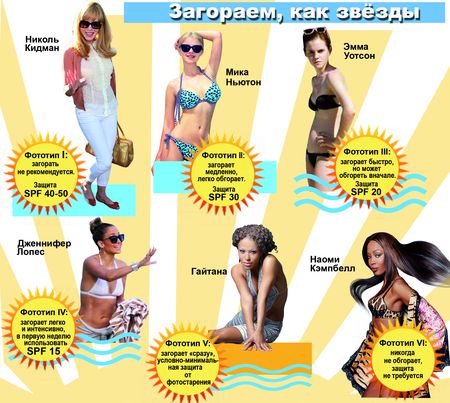
Sunbathing should be used wisely and extremely carefully, avoiding excessive sunlight. Sun protection includes several points. Firstly, when planning a vacation at sea, you need to think in advance about the comfort and safety of being in nature. Sun protection products will help you protect yourself and protect your skin as much as possible from the unwanted and harmful effects of sunlight. Secondly, when purchasing special protective cosmetics for the skin of the body and face, be sure to take into account the type of your skin and carefully read the instructions for use on the package.
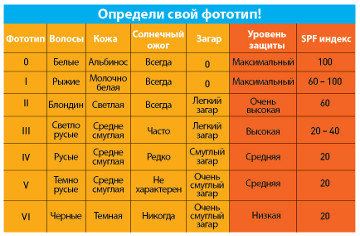
Having determined our phototype, we will understand what kind of SPF index we need.
There are special rules that allow you to correctly and competently select the funds you need and use them for their intended purpose.
sun protection
![]()
Children's skin is especially sensitive to the summer sun.
When purchasing sunscreens, you need to focus on their composition. It must be indicated on the tube with the product and protection against types of radiation is indicated. Physical sun protection includes the content of zinc oxide and titanium dioxide in sun protection products, they help to successfully repel the rays that hit the skin. Chemical protection from the sun implies the content in them of components that filter ultra-violet rays and converting them into pleasant body heat. These compounds protect cells from various neoplasms and accelerate skin aging.
Sun cream should be applied to the body, following all the recommendations indicated in the instructions.
Safe time in the sun
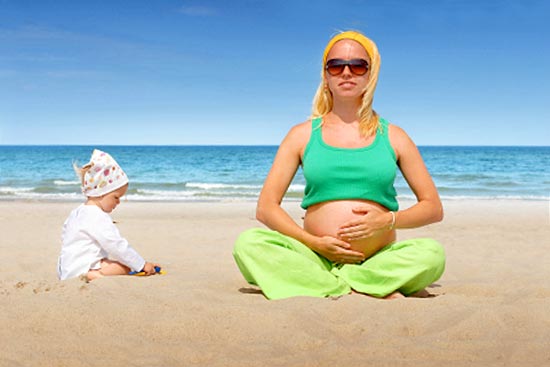
Safe time for sunbathing is before 10:00 and after 17:00. From 10:00 to 17:00, air baths in the shade.
Take advantage of sunbathing.
First of all, remember that solar procedures can only be taken at a safe time for this, in the morning, before 11 o'clock, and in the evening, starting from 16-17 o'clock. If you have not sunbathed this year yet, then the time spent in the sun should be increased gradually.
Allergy to the sun
Allergy to the sun is now a common problem, it affects about 20% of the population. If you have it, then sun exposure should be kept to a minimum, no more than 20 minutes in total. The same should be done if you have a lot of moles on your body. After visiting the beach, take a shower and apply an after-sun product. The skin needs to recover from sunbathing.
You can use various cosmetics for this:
- cream;
- lotions;
- serum.
Any of them should contain special oils, acids, extracts that help heal wounds and soften sunburn.
Choose nourishing creams with sun-reflecting particles.
If the previous tan is still felt on the skin, it is not recommended to be in the midday sun.
If you have dry problematic skin, it is better to use various serums, as they have a molecular structure and contribute to the nutrition and regeneration of the deep layers of the skin, moisturize it, and promote metabolism. It is important that the content includes natural extracts and hyaluronic acid.
The summer sun gives your body a positive charge for the whole year, but you need to use it in moderation.
With love and care for the closest.
If you do not have special protective equipment at hand after getting a sunburn, we suggest using proven folk methods. They will immediately help to get rid of the resulting stress, reduce pain and redness on the body. To folk remedies include masks that can be prepared from products at hand. These are kefir, honey, rice, milk, eggs.
Protecting your hair from the sun
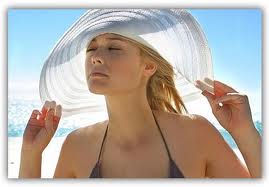
Wear a hat when in the sun.
Protecting your hair from the sun is also an important point that many people neglect while on vacation. Here you can not do without special cosmetics. These are special shampoos and conditioners that contain natural oils and moisturize the hair well. If necessary, split ends of the hair can be trimmed and special serums for split ends can be applied. After such care, the hair will look well-groomed, healthy and have a chic look. And you should also wear hats, caps or panama hats, because they not only protect your hair from the scorching sun, but also prevent the occurrence of solar heat stroke.
Don't forget to put your glasses on or put them in your bag when you leave the house. Sunglasses are more than just a trendy accessory. They will protect your eyes from bright sun exposure and prevent wrinkles around the eyes.
Who among us does not like to relax and bask in the sun, and also get such a welcome tanned look.
But exposure to the sun can cause wide range skin problems.
To understand what processes occur in the skin during tanning, consider the rays that come to us from the sun.- this is alpha and beta ultraviolet rays.
In the cosmetic industry, they are referred to as UVA and UVB.
Beta rays UVB rays
, acting on the skin, contribute to the compaction of its stratum corneum (epidermis).
Under their influence, the cells under the epidermis receive protection.
Melanin is produced in the skin, as beta rays stimulate melanocytes - cells that contribute to the formation of pigment. Melanin gives the skin a dark shade and performs a protective function.
But when too strong tan beta rays damage cell walls, causing burns.
Alpha rays (UVA), unlike beta rays, they do not heat, it is impossible to feel their effect on yourself.
They will not cause a burn, but, having penetrated into the deeper layers of the skin, they can provoke increased sensitivity to the sun, as well as skin aging, which reduces its immunity.
Alpha rays penetrate even through glass.
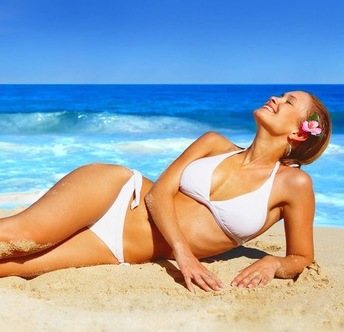
How to protect yourself from the sun: the principles of tanning
You should not be afraid of being in the sun, especially since we all simply need the sun, because without it it will not work out in the body vitamin D very important for bone health.
Also without the sun is not produced happy hormone seratonin which relieves us of depression.
Therefore, you can and should sunbathe!
You just need to know a few simple rules!
The rules for staying in the sun are so simple that everyone knows them:
- do not sunbathe between 12 and 16 hours
- don't be in the sun for too long
- use protective equipment while on the beach
Exist special sun protection helping to get an even tan and not have problems from communicating with the sun.
So what is sunscreen?- a cosmetic product in the form of a cream, lotion, oil or lipstick for lips, which includes one or more ultraviolet filters.
Types of products for protecting the face and skin from the sun
- Sun milk. Typically used on the entire body
- Sun creams. Mainly used on the face
- Gels without fat additives and emulsifiers. They are used with a tendency to inflammation of the sebaceous glands.
- Hair protection products.
- Sun lipstick and gloss
For competent handling of sunscreens, we will understand sunscreen terminology.
Sun protection terminology
Choosing the right sunscreen!
If the sunscreen package says:
UVB- these are ultraviolet B-filters that absorb ultraviolet radiation in the range of 290-320 nm, however, they do not protect the skin from ultraviolet A-radiation, which, although it does not act as strongly as B-rays, penetrates much deeper and can cause only photoaging of the skin but also carcinogenesis (development of skin cancer).
UVA are ultraviolet A-filters capable of absorbing Sun rays in the range of 320-400 nm. Regular use of these cosmetics protects the skin from premature aging and can significantly reduce the risk of malignant tumors skin.
SunbIok, Broad specyrum- contain ultraviolet filters that reflect the entire spectrum (ultraviolet rays A and B). These broad-spectrum filters provide better protection not only for the skin, but also for the immune system against the harmful effects of ultraviolet radiation.
SPF (Sun Protection Factor)- sun protection factor, which gives an idea of the effectiveness of ultraviolet B-filters. For example, the SPF2 written on the tube means that after treating the skin with this sunscreen, you can sunbathe 2 times longer than usual without fear of getting a skin burn.
Odds from 4 to 45 divide all funds into three groups:
(45-15) - strong defense,
(15-8) - medium, etc.
American and European sunscreens have different ratios.
In Germany, the sun protection factor is referred to as LSF, which is slightly lower than SPF.
For example, SPF 15 corresponds to LSF 10.
It is advisable to use sunscreens with the highest SPF, especially for people with fair and thin skin, children.
water resistance- means that the sun protection factor does not decrease after 40 minutes of swimming.
Water Proof- means that the SPF is not reduced after 80 minutes of swimming.
PABA-free- this means that this product does not contain para-aminobenzoic acid (PABA). More recently, it has been used quite often as a UV filter, but later it was found that PABA and its derivatives often cause allergic reactions.
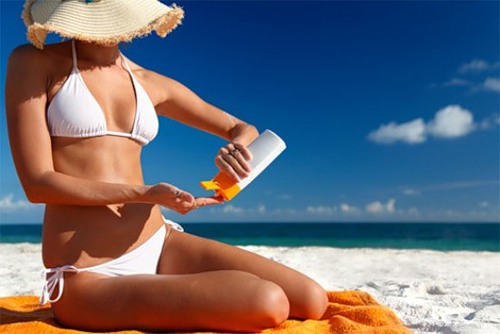
How to protect your skin from the sun?
Apply sunscreen to dry skin about 20-30 minutes before tanning.
Apply the product evenly until completely absorbed. Then every 2 hours you need to repeat this procedure.
Also don't forget about ears and neck.
Lips We need to protect it with a special sunscreen lipstick.
After sunbathing, the skin needs to replenish moisture..
For this you need to use after sun or sensitive skin care products.
These products will moisturize, soothe the skin and help to keep the tan longer.
If your apartment windows face south, you are definitely familiar with the problem that I want to talk about below. Significant discomfort caused by the scorching sun can turn a room even with a designer interior into a real oven.
After all, excessively bright lighting can not only irritate the eyesight, but also overheat the air in the room, which raises the logical question of how to darken the windows in order to avoid such a scourge.
Since I am familiar with all the "charm" of the sunny side of the house, I wanted to get rid of this problem once and for all. After asking friends and surfing a lot of pages on the Internet, I found some of the most successful (so it seems) ways to darken windows. I will talk about them below.
Ways to completely darken windows
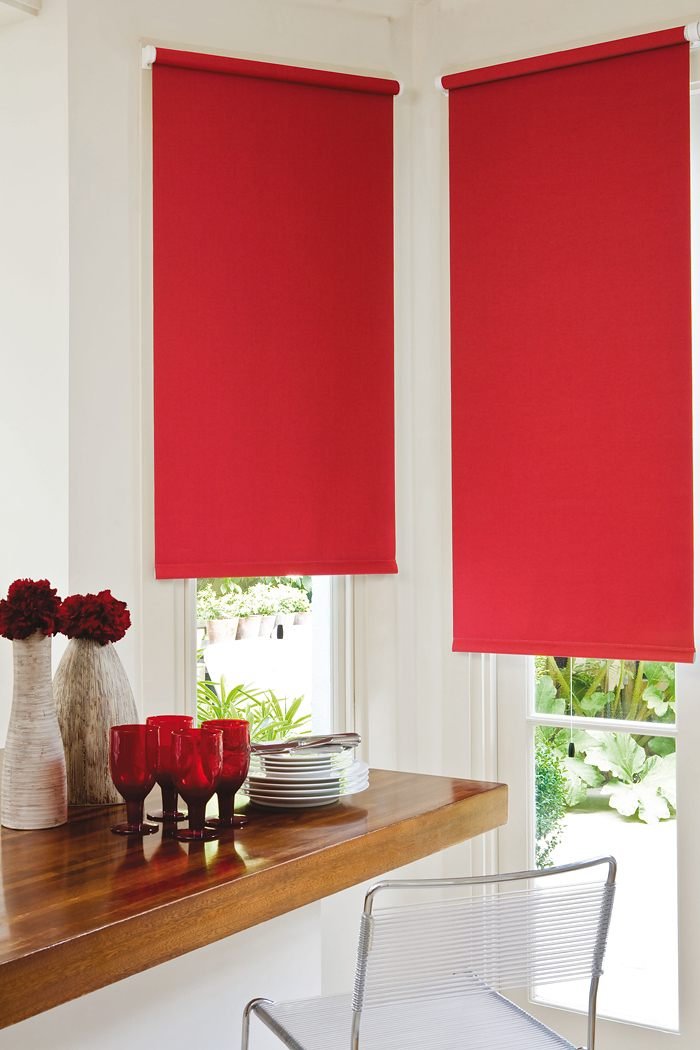
I want to warn you right away: all the options described below for protecting windows have different characteristics and properties. Therefore, before rushing to buy at random, it is better to familiarize yourself with them.
Method 1. Blackout curtains
The first thing that was advised to me in the process of searching for the perfect protection was blackout curtains on the windows from the sun. This is one of the most affordable and budget options. Here are a few simple tips that will make their operation even more convenient:
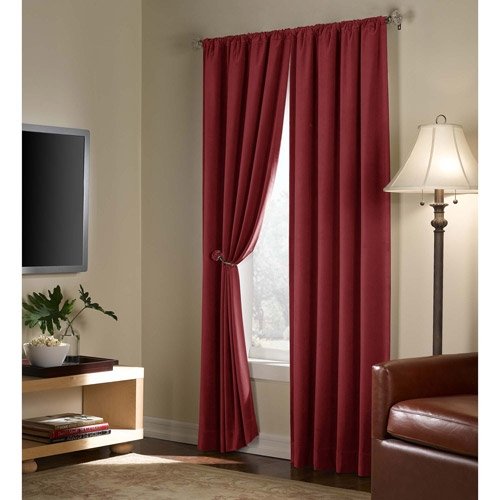
- Choose a dense material for curtains of necessarily light shades. So the curtains will heat up less, and accordingly they will not let the heat into the room.
- If you want to achieve maximum protection from sunlight, give preference to Blackout curtains (blackout). Such models are made of a three-layer opaque fabric, they are able to completely reflect the light and darken the room.
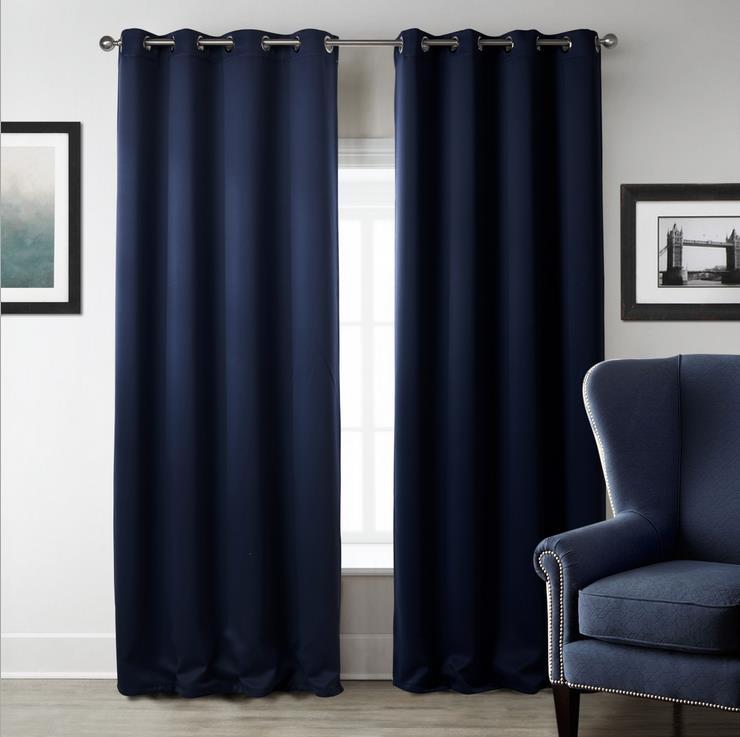
- To ensure good blackout in the apartment and at the same time not to buy heavy dark curtains, you can successfully combine several light options with each other. Create an interesting ensemble of curtains of different materials, weights and designs, and turn them into multi-layered protection.
Despite the fact that blackout curtains are excellent protection from the sun on the windows in the apartment, they also have their drawbacks:
- First, such models significantly impede the influx fresh air into the room.
- And secondly, they simply quickly accumulate dust and need constant washing.
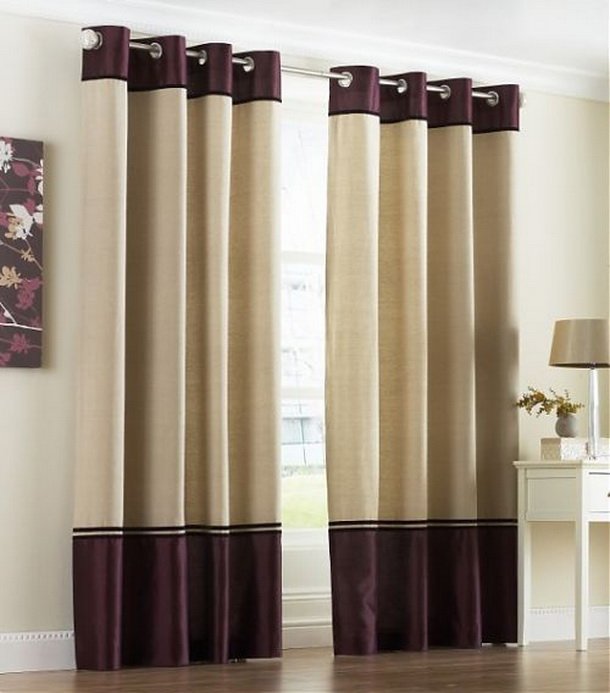
Method 2. Lamella curtains
Lamella curtains (they are also blinds) have been occupying a leading position among the most popular methods for framing window openings for many years. Depending on the features of the application, they are divided into internal and external. I would like to dwell on each type separately.
Internal
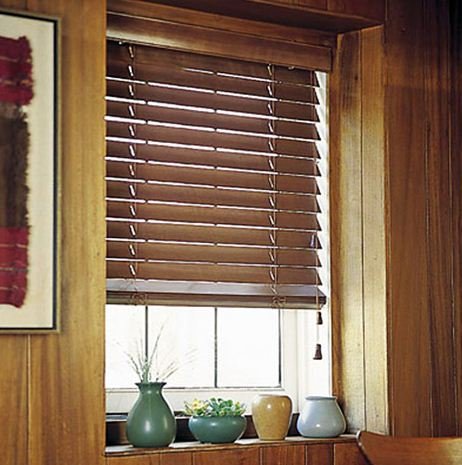
The topic of internal blinds comes up especially often when the question arises “how to close the windows from the sun on the balcony”? Nevertheless, this version of curtains is no less popular for decorating openings in rooms. I think there are several reasons for this:
- Blinds make it possible to easily adjust the amount of light due to the possibility of turning the slats, of which they actually consist.
- They are quite easy to install on the window frame.
- Lamella structures can fit into almost any. And in combination with bright curtains, they will create a rather original tandem.
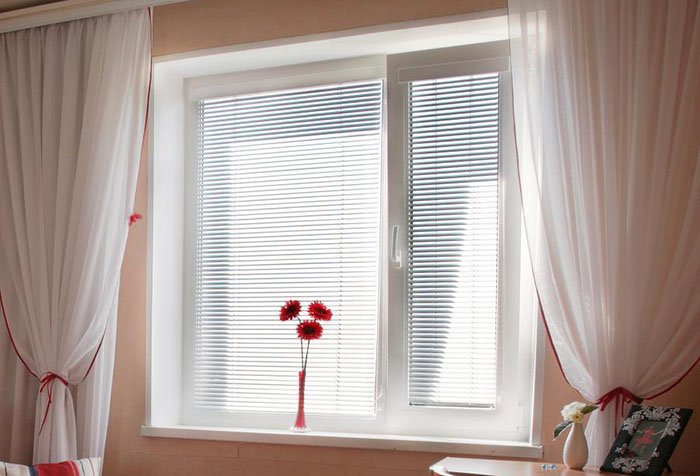
Of the minuses, I want to note some difficulties in cleaning such products. Someone will say that it is enough just to close them and wipe them with a damp cloth. Personally, I had to wipe each socket separately for a significant effect.
outdoor
External blinds are made of more durable material and wider slats. In addition to the fact that these are quite effective sun protection systems, they will help to hide what is happening in the apartment from prying eyes (residents of the first floors, take into account).
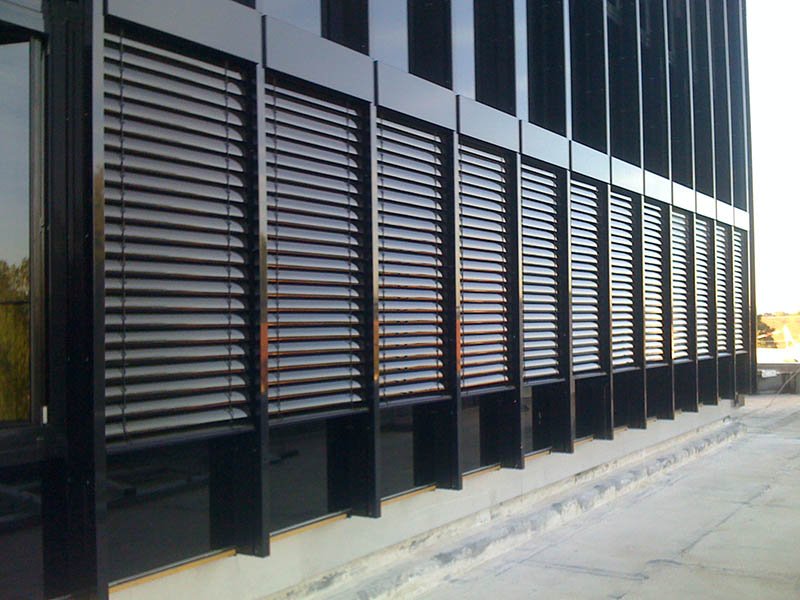
Most often, in the process of manufacturing such a lamellar structure, galvanized metal is used, less often - wood. The thing is that from constant exposure to rain, light or snow, wooden sun blinds wear out faster.
Method 3. Roller blinds
Convenience, practicality, reasonable price - these epithets are quite suitable for rolled curtains (well, I love them, what can I do). Why are such models good?
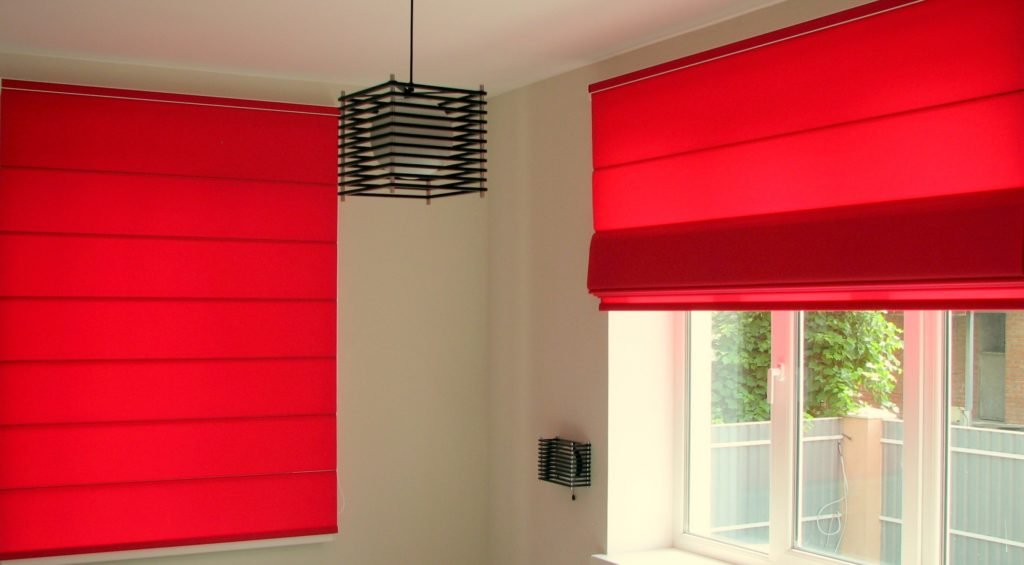
- By fixing the curtains not above the window, but directly on the double-glazed window, you will achieve the maximum fit of the material to the window, which will prevent light from penetrating the sides. Naturally, the sun protection of the room will only benefit from this.
- A wide range of roller blinds makes it possible to decorate almost any interior and type of room.
- Now they produce curtains with opaque, reflective and light-diffusing effects - choose - I don’t want to! Almost all roller blinds from the sun on the windows are treated with dust-repellent impregnation, so you will not have problems with cleaning.
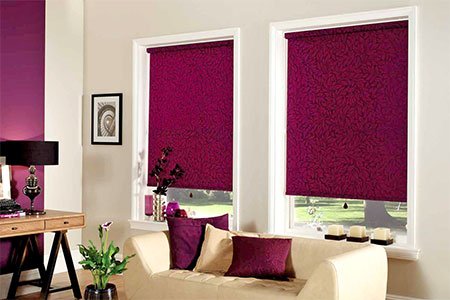
- High-quality constructions completely prevent hot rays from entering the house, thereby preventing overheating of the air in it.
So when thinking about what to hang on the windows, do not forget about such a simple and effective option. Their installation does not take much time or certain skills. And if you wish, you can make such curtains with your own hands.
Method 4. Film
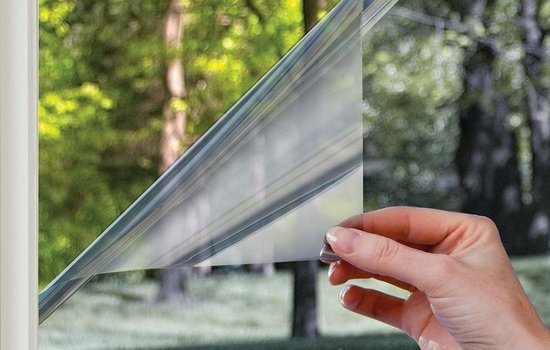
Despite the many advantages, all of the above methods of protecting an apartment from sunlight have one huge disadvantage. Such models close the view from the window, and this has to be reckoned with.
If a wonderful view opens through the window opening, then it is not worth sacrificing it at all. Plus, you have a great alternative to standard curtains: sun screens.
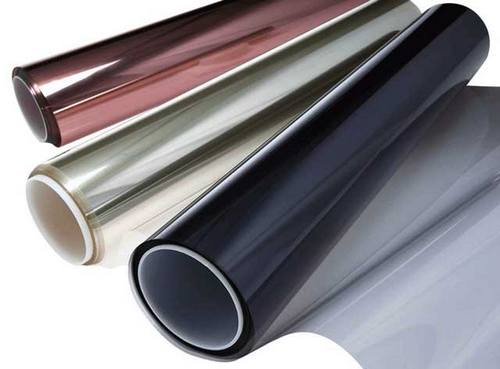
In fact, this is not a screen in the full sense of the word, but a special, almost transparent film that is glued directly to the glass. I want to immediately please housewives: such a coating does not require absolutely no maintenance.
This option perfectly reflects infrared rays and helps to reduce the flow of solar heat.. At the same time, the level of lighting in the room remains unchanged.
Due to the fact that protective films are produced with different degrees of protection, you can choose the level that suits you best. I've even found fully mirrored models that will make your sunshades opaque to prying eyes (another handy solution for ground floor residents).
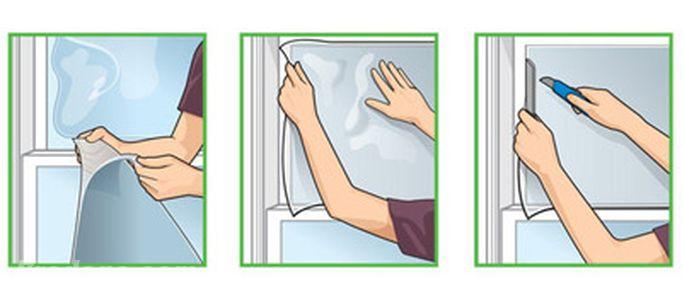
And finally, one more advantage of using film. Due to this material, the glass is strengthened, and in more detail: upon impact, it will not shatter into fragments, but will remain directly on the film. So, if you are still thinking about what to stick on the window, then you may have a favorite.
Options for partial dimming
If you do not need to completely darken the windows, but the question of how to hang the openings is still relevant, the following options will be an excellent alternative:
- Bamboo blinds. They effectively transmit diffused soft light and look great in most interiors.
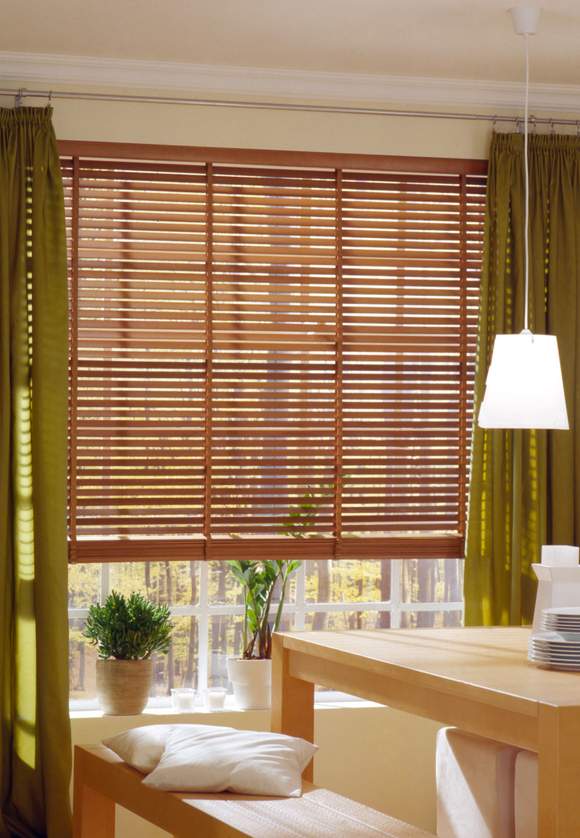
- Pleated blinds. A model made of pleated fabric is another way to dose the sun's rays into the room. In addition, in some models you can comfortably adjust the height of the curtains, which is a definite plus.
![]()
Many note the sophistication and usefulness of the day-night model. This option is created using two types of fabric - translucent and dense. Depending on your needs, the system will create low or high blackout, and will also help if you need protection from the street.
- Marquises. Another way to hide from the scorching sun and at the same time not lose the beautiful view from the window. Awnings, made of dense canvas, are usually hung outside the opening.
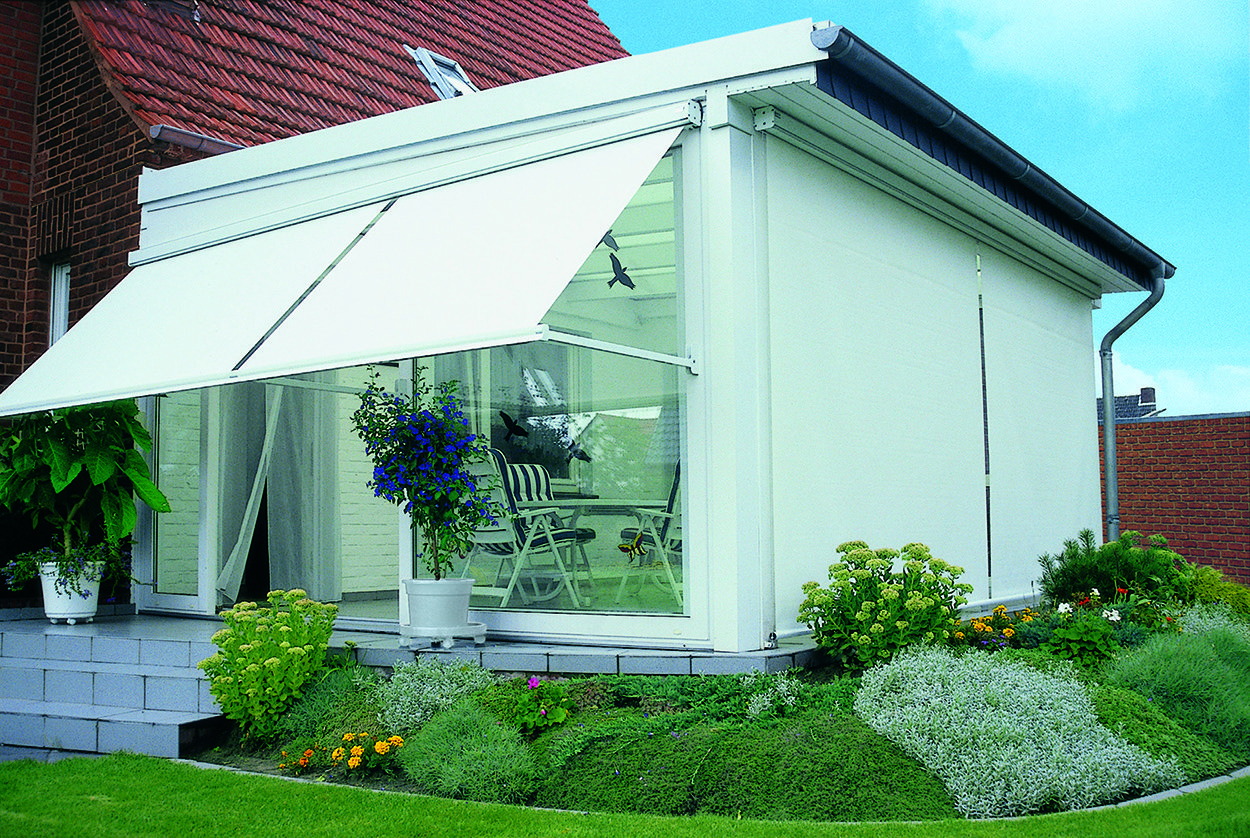
These cute and original visors do not absorb dirt and do not get wet. And you will have the opportunity to adjust the degree of inclination or the width of the canopy.
Do not think that such a shelter is good only for a private house, awnings are also successfully used on an ordinary balcony. Believe me, even on the wall of an ordinary Khrushchev, this model will look original and unusual.
- Roman curtains. When it comes to how to curtain windows in an apartment, I cannot but mention Roman curtains. They have an excellent reflective effect, besides they are quite compact and easy to use.

Summing up
I won't be able to tell you what's best to use as your room's primary sun protection, but I've tried to outline the most practical options for you. Basically, each of them right choice and the installation will be able to serve well. The video in this article will tell you about additional nuances of dealing with scorching rays.
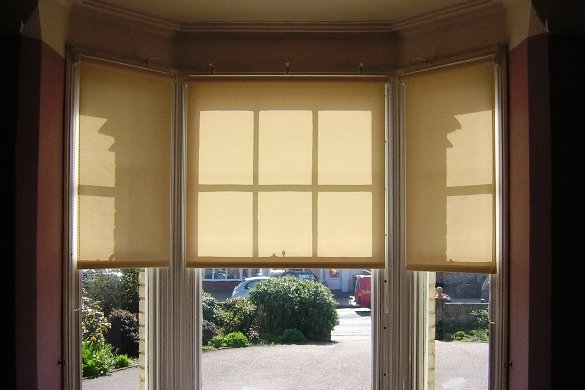
Good window protection - no problems with heat
Perhaps in this material I have not described all the possible and practical options. If you know about other ways to protect the room from the hot sun, be sure to share them in the comments.
October 17, 2016If you want to express gratitude, add a clarification or objection, ask the author something - add a comment or say thanks!
At the height of summer, we figured out how and what sunscreen cosmetics protect us from, as well as why we use more sunscreens, and the incidence of melanoma is increasing.
How does the protection factor protect
When choosing sunscreens, most people rightly focus on the SPF protection factor. This abbreviation comes from the English Sun Protective Factor and stands for sun protection factor, which characterizes the degree of protection provided by this cream. SPF is listed in large numbers on each bottle. The higher the number, the greater the protection.
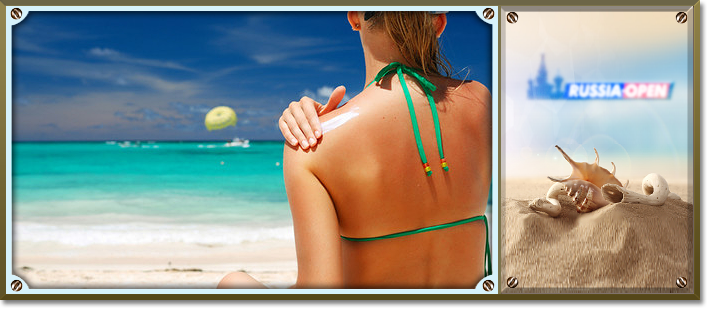
Before using sunscreen, you need to realize what skin phototype nature has given you. It depends on the production of melanin - a dark pigment that is contained in the cells of the epidermis and absorbs light. If there is a lot of melanin, a person has naturally dark skin, while he tans well and does not burn in the sun. If it is not enough, a person has very light skin, which turns red and burns even with a short stay in the sun. Often the owners of such skin have red hair. Most often, the skin belongs to the intermediate type, and in total there are six phototypes.
For the first and second phototypes (light-skinned), a high protection factor (SPF> 20) is needed, for the fourth-sixth phototypes, a rather low one (SPF< 10).
It is believed that the protection factor number indicates how many times longer you can stay in the sun with sunscreen than without it. For example, if without a cream your skin turns red in the sun in half an hour, then with SPF4 cream this time increases to two hours.
Redness of the skin (erythema) is the first stage of a sunburn, and then, as you know, the skin peels off, the top layer of the epidermis comes off. Nobody wants to get burned in the sun, and that is why we use protective equipment. They protect the skin from burns.
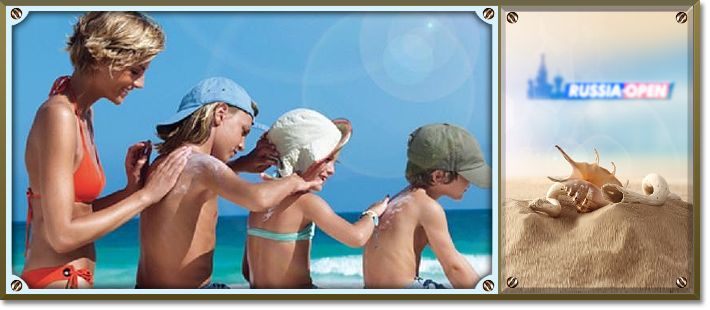
From burn to cancer
But red and peeling skin is not all the trouble that we get from the sun. Radiation in the ultraviolet (UV) range damages skin cells, which leads to their increased aging (photoaging) and increases the likelihood of skin cancer, primarily its most dangerous variety - melanoma. This is because UV radiation damages biological molecules. Under its influence, photochemical reactions occur, leading to the appearance of free radicals - molecules with an unpaired electron that damage proteins and DNA.
If the skin protein collagen is damaged in this way, the skin ages intensely. If the changes affect the DNA, the cell can become cancerous.
In the solar spectrum, UV radiation is divided into three ranges depending on the wavelength. The shortest UV-C rays (200–290 nm) hardly reach the Earth's surface due to the atmosphere and its ozone layer; UV-B (290–320 nm) and UV-A (320–400 nm) are what our skin gets. But they act differently.
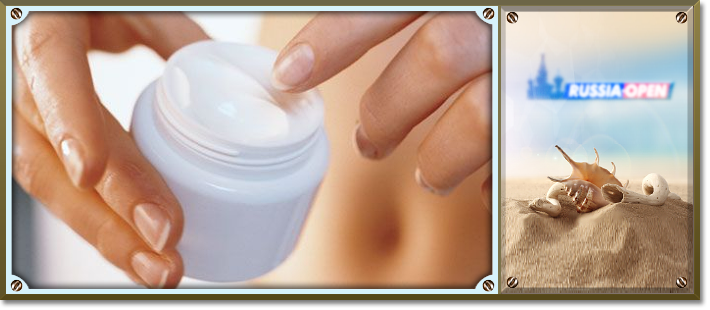
UV-B, as a shorter wavelength, has more energy and burns the skin more, which is what we are most afraid of. UV-A at first glance is more harmless radiation, it does not burn as much, but it penetrates deeper into the cellular layers of the skin, into the dermis. This means that it is this range of ultraviolet that brings with it dangerous consequences - photoaging and cancer.
Accordingly, the letters UVB or UVA are indicated on the bottle of sunscreen. For example, UVB means that the product only protects you from UV-B rays, that is, only from sunburn. But on modern products of good brands, as a rule, the letters UVA circled are also indicated. This means that the product protects not only from UV-B, but also from UV-A rays.
For those who want to tan, it would be interesting to know: will any amount of ultraviolet light break through the double protection to get a beautiful skin tone? In addition, ultraviolet radiation is “not only harmful, but also beneficial”: under its influence, vitamin D, which is extremely important for the body, is synthesized in the skin and various other beneficial processes occur. For example, blood pressure decreases, and with it the risk of heart attacks and strokes.
Fans of a tanned body need not worry: the body will not remain completely without ultraviolet radiation even with protective equipment. Firstly, they are usually smeared with an insufficiently thick layer on the skin (the norm is 2 mg of cream per 1 cm 2), so they still do not work at full strength. Secondly, any protection does not eliminate ultraviolet, but only weakens its effect.
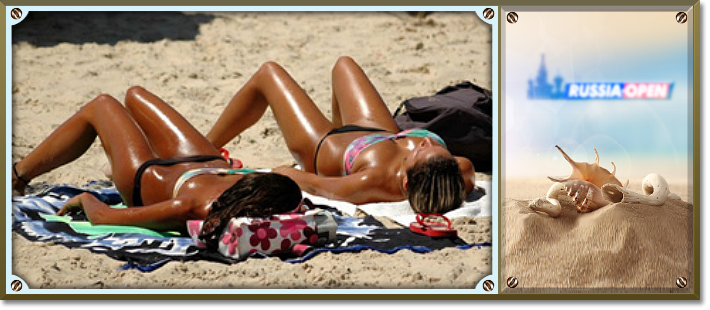
Another important factor to consider is that the spectrum of solar radiation is not the same at different times and at different latitudes.
At noon (according to astronomical time), the intensity of radiation at a wavelength of 290–320 nm (B-band) is ten times higher than at 9.00 or 15.00.
The reason is that the sun at this time is higher above the horizon, and in the morning and evening hours it falls to the ground in oblique rays, which travel a greater distance in the atmosphere and are scattered more strongly. For the same reason, the intensity of short-wave radiation is greater, the closer one is to the equator. In other words, when going on a trip to the tropics, you need to keep in mind that the sun will burn more strongly not only with heat, but also with ultraviolet radiation. And accordingly, increase the level of protection. More intense ultraviolet is also in the mountains, increasing by about 6% for every kilometer of altitude.
Do creams help cancer?
Do sunscreens protect against cancer? Science and medicine do not yet have a clear answer to this question.
Optimism is hindered by the fact that the incidence of skin cancer, including melanoma, is growing in the world.
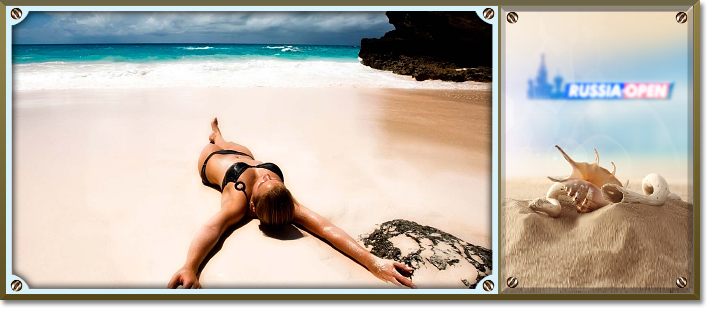
Although, it would seem, it should decrease, because people now use sunscreen much more.
According to the World Health Organization (WHO), more than 130 thousand cases of melanoma and 66 thousand deaths from melanoma and other forms of skin cancer are registered annually in the world. Compared with the middle of the last century, by the beginning of the 21st century, the incidence of melanoma has increased six times. Most high level noted in those countries whose population has fair skin and where it is customary to sunbathe in the sun: in Australia, New Zealand, North America and Northern Europe. In Norway and Sweden, the annual incidence of melanoma has more than tripled in the last 45 years, and in the US it has doubled in the last 30 years. Top performance melanoma cases have been reported in Australia, where many residents are of northern European descent and live in climates with significantly higher solar radiation.
Experts have three hypotheses to explain why people use sunscreen more often and melanoma is on the rise.
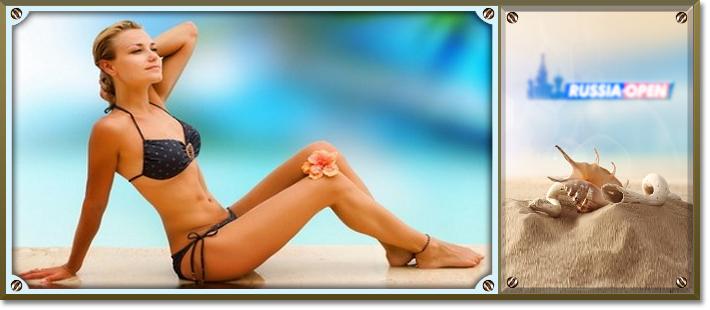
First, this type of skin cancer develops slowly, its latent period is 20-40 years.
So it's possible that today's melanoma victims received a dangerous dose of radiation in their early youth, when sunscreens were not yet so popular.
And the fashion for a tan began in the 1950s, when tanned skin became a sign of well-being and prosperity.
Secondly, the ozone layer of the earth's atmosphere is becoming thinner, which reduces the effectiveness of its protection from ultraviolet radiation.
Perhaps this is the answer to the question, how did we all live before, going out into the sun without any creams? The sun was less aggressive.
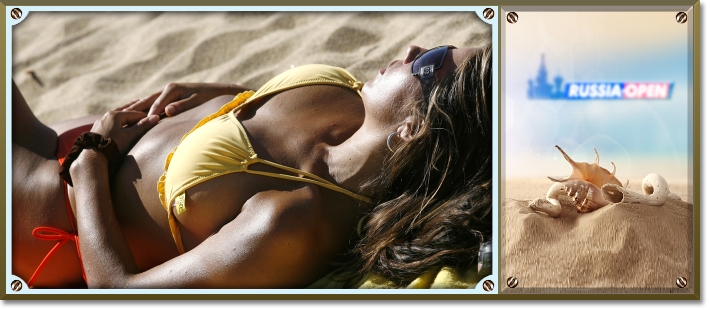
The third hypothesis is the most unpleasant: perhaps sunscreens not only protect against cancer, but also provoke it.
Feeling safe, people, smeared with cream, spend much more time in the sun,
however, they may not apply the cream to the entire body or less than necessary, or wash it off with water (experts say that waterproof products are a myth). Thus, they get more exposure to UV-A radiation along with the risk of getting cancer.
Finally, the substances that work in sunscreens and sprays may not be safe themselves. They include physical UV absorbers that reflect and scatter the sun's rays - these are zinc oxide and titanium dioxide. Another group of protective substances are chemical UV filters that reduce the effect of radiation on cells. If you read their list on the package, few people will like the names: para-aminobenzoic acid (PABA), although many manufacturers have already abandoned it, as it can cause allergies; octylmethoxycinnamate, benzophenone-3, 4-isopropyldibenzoylmethane, etc. They penetrate the skin, and how they act with long-term use has not yet been properly studied. For example, a 2001 report released by the Environmental Working Group (EWG) states that many popular sunscreens contain ingredients that may be carcinogenic.
Studies that have tried to objectively prove whether sunscreens protect against cancer have yielded conflicting results.
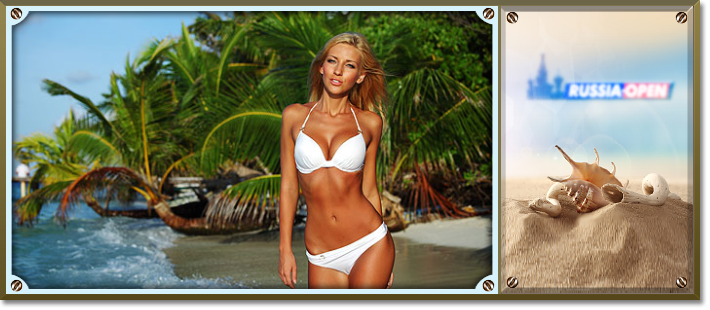
Here is what the European recommendations for the fight against malignant tumors, which are given on the website of the Anticancer Society of Russia, say: “These drugs can protect against squamous cell carcinoma, but at present there is not enough convincing evidence that they have a protective effect in the case of basal cell carcinoma. cancer and melanoma. When using them, it is very important to avoid prolonged exposure to the sun, which can lead to an increased risk of melanoma.”
Scientists at the Memorial Sloan-Kettering Cancer Center, after analyzing the association of sunscreen use with squamous cell carcinoma, basal cell carcinoma, and melanoma, say that sunscreens protect against these cancers and do not lead to vitamin D deficiency, but only when applied correctly to the skin.
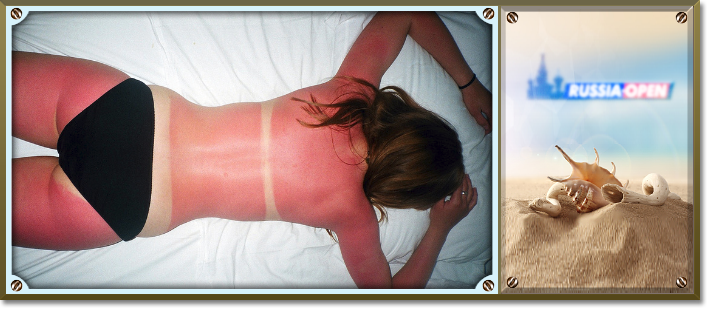
According to the data provided by a specialist in oncodermatology, experts from the International Agency for Research on Cancer studied the preventive effect of sun exposure. protective cream to the development of skin cancer. They found that the use of a barrier cream could prevent erythema and squamous cell carcinoma. For basal cell carcinoma and melanoma, this effect has not yet been determined due to the difficulty of investigating a long latency period. Paradoxically, there is conflicting evidence that sunscreen use may increase the risk of melanoma with increased sun exposure. Of the 15 studies, only 3 showed a significant reduction in melanoma risk, 4 showed no significant effect, and 8 showed an increase in risk.
Solar circle - the sky around
How to protect children from the sun is a separate issue. Dermatologists emphasize that an excess of ultraviolet radiation in childhood most dangerous for the risk of developing melanoma during life.
The child has a very thin epidermis, and melanocyte cells that produce melanin begin to work only by the end of the second or third year of life.
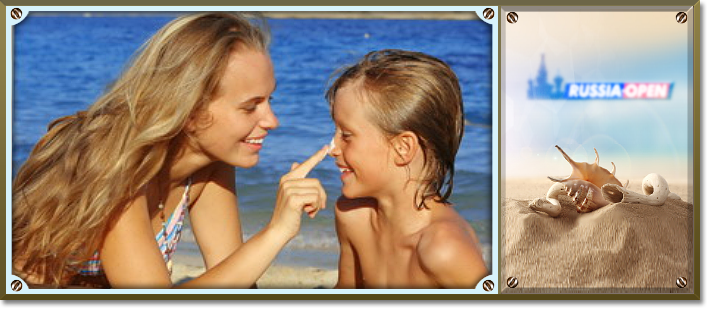
Should you put sunscreen on your kids? Some scientists who have studied this issue argue that an oil-based emulsion containing physical filters is best suited for children. Although chemical filters are also indispensable in order to achieve the SPF-50 protection factor, which is recommended for children. But at the same time, oxybenzone and octocrylene should be avoided in the composition.
And it is best to keep smaller children in the sun at noon and wear light cotton clothes and a panama hat on their heads. Russian pediatricians believe that up to three years a child should not be under the scorching rays of the sun at all, and from three years old - no more than 15 minutes.
And adults should also remember that no protective cosmetics can replace a head on their shoulders. The sun in large quantities, like alcohol, is dangerous for your health.
